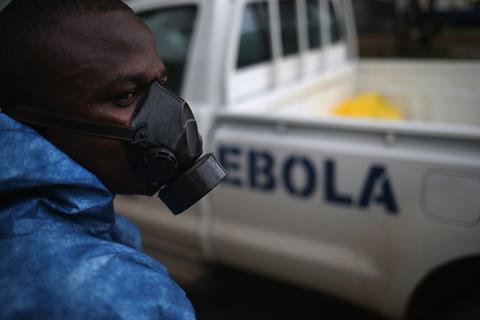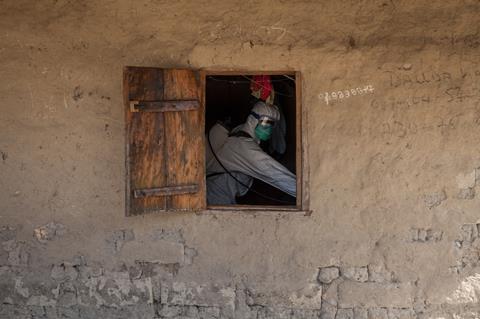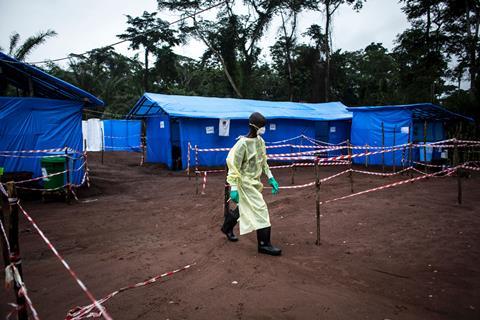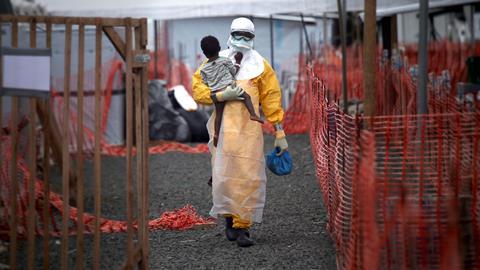Clare Sansom examines the need for agile drug development when tackling emerging viral disease outbreaks
The death of one-year-old Emile Ouamouno in an isolated village in Guinea, West Africa, in December 2013, will have seemed at the time to be no more than a family tragedy. Yet little Emilie had his own place in medical history: he was the first victim of the most widespread outbreak of Ebola ever recorded. This viral disease kills on average about half of those infected and has no known cure. It was first identified in Zaire (now the Democratic Republic of the Congo) in the 1970s, but until a few years ago it had only ever occurred in isolated, short-lived outbreaks. The first few cases in 2013, however, spread into a truly frightening epidemic, killing over 11,000 people in three neighbouring countries: Guinea, Liberia and Sierra Leone.

This changing story illustrates the speed with which infectious diseases can emerge from obscurity to become the most urgent and important of health priorities. Before 2014, Ebola was not considered a research priority and there are still no licensed vaccines or drugs available to treat it. Paradoxically, one ‘advantage’ of the recent outbreak was that it was large enough, and long-lasting enough, to make clinical research and even clinical trials feasible. Scientists and clinicians are now better prepared to carry out research with few resources in challenging epidemic situations, but there is still much to learn. ‘We need to find out what can be done better in future epidemics. It is the least that we owe to the thousands who died,’ says Peter Piot, director of the London School of Hygiene and Tropical Medicine, UK. As a young microbiologist working at the Institute of Tropical Medicine in Antwerp, Belgium, Piot had been part of the team that discovered and characterised the Ebola virus.
Epidemics burn themselves out quickly, which is good … but not for clinical research
Peter Horby, University of Oxford
The Ebola epidemic has given a new impetus to efforts develop drugs and vaccines for emerging epidemic diseases worldwide. The Coalition for Epidemic Preparedness Innovations (CEPI), which focuses on vaccine development has already received well over $500 million (£377 million) from several governments, the Gates Foundation and the Wellcome Trust. The secretary of the Indian government’s Department of Biotechnology chairs its board, with Piot as its vice-chair. ‘This is the first time that India has been such a major player in an international collaboration of this kind,’ he comments.
Predicting the unpredictable
Ideally, researchers need to be ready to kick-start the drug development pipeline before the next epidemic of an emerging virus strikes. This would require a ready supply of vaccines, small-molecule drugs or other therapies with at least some evidence of safety and efficacy, established trial designs and logistical support. But it is impossible to know what the next epidemic will be, or where it will strike. So they must rely on predictions. In May 2016, the World Health Organisation (WHO) published an ‘R&D blueprint’ listing nine viral diseases of priority importance. A tenth, Disease X, is also included – shorthand for ‘any disease identified [as priority] before the next review’.

Zika is on the list. First isolated in 1947, the Zika virus generally causes mild flu-like symptoms. It came to the world’s attention suddenly early in 2016 when a widespread outbreak in Brazil was linked to microcephaly and other birth defects. ‘If you’d done the WHO prioritising a few years ago, you’d never have put Zika on that list,’ says Peter Horby of the epidemic disease research group at the University of Oxford, UK and chair of the International Severe Acute Respiratory and Emerging Infection Consortium (ISARIC). The epidemic in Brazil burned itself out later that year, but Zika is now one of the top emerging disease priorities for drug discovery, and the ethical and logistical problems associated with testing a drug to protect unborn children are being widely discussed.
‘Most epidemics do burn themselves out quickly, which is good for potential victims but bad for clinical research,’ says Horby. ‘The 2014–16 Ebola epidemic was longer than most, but even there we only had just enough time to set up and run a few clinical trials.’ Drugs can only be tested during epidemics, and researchers need to enrol enough patients to reach statistical significance. ‘Drug and vaccine developers need to be agile, ready to start clinical research promptly whenever and wherever an epidemic occurs,’ he adds.
Our Ebola programme started with a tweet from a friend in Sweden
Sean Ekins, Collaborations Pharmaceuticals
In this context, agile drug discovery means taking molecules as far as possible through the discovery pipeline before there are any patients available for clinical testing. If possible, a molecule or molecules should be checked for safety in pre-clinical models and trial designs prepared perhaps years before an opportunity arises to try it in patients. But where do these molecules come from? And how are the development costs to be covered?
Ahead of the game
Collaborations Pharmaceuticals, a tiny company based in Raleigh, North Carolina, US, is about as different from Big Pharma as it is possible for a drug discovery company to be. It was set up by Sean Ekins in 2015 with the aim of exploiting data already in the public domain to develop small-molecule drugs for rare and neglected diseases. As its name suggests, it works in collaboration with academic groups, charities and even other companies. Most of its funding comes from the US government’s National Institutes of Health. Compounds are initially selected using high-throughput computational screening; the current clinical pipeline includes drug candidates for tuberculosis and rare developmental disorders as well as epidemic viral diseases.
‘Our Ebola programme started with a tweet from a friend in Sweden’, explains Ekins. ‘The epidemic was raging, we knew of no small molecules being tested against the virus, and I was challenged to use our machine-learning algorithms to find some.’ A screen of a 2320 drug molecules led to the identification of three promising compounds – quinacrine, pyronaridine and tilorone. These compounds were then tested against the Ebola virus in vitro and all found to be active. The first two of these are registered anti-malarial drugs that share the same 4-aminoquinoline scaffold as chloroquine; the third is an antiviral and an interferon inducer. ‘The advantage of testing compounds that have been approved for other diseases is that we know their pharmacokinetics and can predict likely side effects, so they start much further down the development pipeline than novel molecules,’ explains Ekins.
ZMapp is an antibody cocktail, and these will never be cheap or quick to make, so we need to have a supply ready
Larry Zeitlin, Mapp Biopharmaceutical
When the Zika story hit the headlines early in 2016, Ekins resolved to see how his company could select promising leads in a very limited time. The result was the OpenZika project led by Ekins, Caroline Andrade of the Federal University of Goiás, Brazil, and Alexander Perryman from Rutgers University, New Jersey, US. This project harnesses ‘spare’ computer power to dock candidate molecules into Zika virus proteins’ active sites via the World Community Grid (see ‘People Power’, Chemistry World January 2013). Since it started in May 2016, millions of computer and Android device users have generously donated over 31,000 years of computer time. ‘When we started, there were no structures of Zika virus proteins in the public domain, and we had to generate models based on structures of related proteins,’ says Ekins. ‘Many of the structures have now been determined, and the results should be more accurate as a result.’ The first batch of hit compounds are now being tested in vitro against the Zika protein NS3 helicase.
When the Zika story hit the headlines early in 2016, Ekins resolved to see how his company could select promising leads in a very limited time. The result was the OpenZika project led by Ekins, Caroline Andrade of the Federal University of Goiás, Brazil, and Alexander Perryman from Rutgers University, New Jersey, US. This project harnesses ‘spare’ computer power to dock candidate molecules into Zika virus proteins’ active sites via the World Community Grid. Since it started in May 2016, millions of computer and Android device users have generously donated over 31,000 years of computer time. ‘When we started, there were no structures of Zika virus proteins in the public domain, and we had to generate models based on structures of related proteins,’ says Ekins. ‘Many of the structures have now been determined, and the results should be more accurate as a result.’ The first batch of hit compounds are now being tested in vitro against the Zika protein NS3 helicase.
So far, Collaborations Pharmaceuticals’ computational screens against the Ebola and Zika viruses have used libraries of compounds that are or have been used clinically for other diseases. This method of drug re-purposing is particularly valuable where time is of an essence as much pre-clinical data will be available in the public domain. Several other companies and academic groups have also set up screens of active compounds against Ebola, Zika and other priority pathogens using a variety of in vitro and computer-based (in silico) methods.
Drug cocktails
Pharmacologist Wei Zheng of the National Institutes of Health in Bethesda, US, and co-workers at Johns Hopkins and Florida State universities have discovered that the Zika virus targets stem cells in the brain known as neural progenitor cells, inducing activity in a protease, caspase-3, and thus triggering cell death. They used this knowledge to design a screen for compounds that inhibit this activity in neural cells and ran about 6000 known compounds through it, testing for both neuroprotection and antiviral activity. ‘Our compound library includes approved drugs, candidate drugs that reached clinical trials and other compounds known to be bioactive’, says Zheng.

They discovered that emricasan, a caspase inhibitor in clinical trials for liver disease, could protect neural progenitor cells from Zika-induced cell death; anti-viral compounds identified included niclosamide, which is used to treat tapeworm infestation. ‘A combination of a neuroprotective and an antiviral compound seems to be particularly effective in vitro, and might be useful in the clinic’, adds Zheng. ‘Our next step will be to test some of these compounds and their combinations in animal models.’
Small molecules may be relatively quick to bring forward into the clinic, particularly if there is pre-clinical data already available, but they are not the only options available. One of the most promising of the current crop of Ebola therapies is Mapp Biopharmaceutical’s ZMapp, a combination of three antibodies directed against the glycoprotein on the Ebola virus surface. ‘We were one of the first companies to begin working on Ebola therapies, back in 2005,’ says Larry Zeitlin, president of Mapp Biopharmaceutical based in San Diego, California, US. During the 2014–16 epidemic, 72 patients were enrolled into a randomised controlled trial of ZMapp plus standard supportive care against supportive care alone, and the death rate was noticeably lower in the patients who had received the antibody cocktail. Unfortunately, however, patient numbers were too low for the results to reach statistical significance.
The results were, however, promising enough for the US government to agree to fund a free supply of ZMapp in whatever resource-poor area a new epidemic arises. ‘ZMapp is an antibody cocktail, and these will never be cheap or quick to make, so we will need to have a supply ready before it is needed,’ says Zeitlin. ‘And this need is almost impossible to predict. An adequate supply has been sent to West Africa in case of another epidemic there, but the next one may well break out somewhere different.’
Lookalike for hire
Lab work with dangerous emerging viruses, whether in academia or industry, is fraught with practical difficulties. In the US and Europe, all pathogens are assigned a biosafety level from 1 to 4. Level 1 pathogens are unlikely to cause disease in healthy humans, and simple hygiene rules are considered to be enough to contain them. In contrast, working with the Ebola virus – at the most dangerous level 4 – requires complex containment facilities, pressure suits for researchers, comprehensive training and an almost paranoid level of security. It is not surprising that most countries have very few level 4 facilities, and with research interest in these viruses growing this can represent a significant bottleneck.
One answer to this dilemma can be found in pseudotyped viruses. These are harmless versions of pathogenic viruses that are made by merging the core of one virus, such as HIV, with the coat of another, perhaps Ebola. These constructs have only one gene, a reporter gene to track infection, cannot replicate and are treated as biosafety level 1. However, to an incoming drug or vaccine they look exactly like the ‘real thing’ and they can be used instead of active virions in many assays.
Drug and vaccine developers have to move fast when an outbreak occurs
Edward Wright, University of Westminster
Edward Wright at the University of Westminster, UK, and his team have developed pseudotyped Ebola viruses to test vaccine and drug candidates. ‘Our pseudotyped viruses can effectively be used to test any vaccine candidate, as these target the surface of the virion,’ says Wright. ‘In the case of drugs, however, they are only suitable for testing those that target the viral coat, such as entry inhibitors.’
And Wright’s group has been involved in testing one of the vaccines in clinical development, in collaboration with the Jenner Institute in Oxford. This vaccine, known as ChAd3, showed some level of protection in West Africa but the epidemic ebbed before this could be confirmed. Vaccines were ready to be shipped into an isolated Ebola outbreak in the Congo in May–June 2017 but the outbreak was contained before they could go. ‘This experience in the Congo proves that early diagnosis, isolation and supportive care can control Ebola very effectively,’ says Wright. ‘It is excellent news, but it does emphasise how fast drug and vaccine developers have to move when an outbreak occurs.’
In 2016, the London School of Hygiene and Tropical Medicine and Harvard Global Health Institute published a hard-hitting report analysing the global response to the Ebola outbreak and suggesting how future pandemics might be prevented before they take hold. Its 10 recommendations concentrate more on governance and resourcing than on science: the only explicit reference to drug and vaccine discovery is of the critical need for robust, rapidly accessible funding. It is already clear that academics and small companies have the motivation and expertise to respond to viral outbreaks rapidly, with innovative and relatively low-cost initiatives: it remains to be seen what could be done if this vital work were better resourced.
Clare Sansom is a science writer based in London, UK
















No comments yet